
views
X
Research source
They can be deciduous, losing their leaves in winter, or evergreen (live oaks), keeping their leaves all year long. Although there is a great deal of variety in the appearance of leaves, bark and other features, all types of oak trees grow nuts called acorns. Since both the nut itself and its scaly cap have many variations, an acorn is often enough to identify the species.
Characteristics of an Acorn
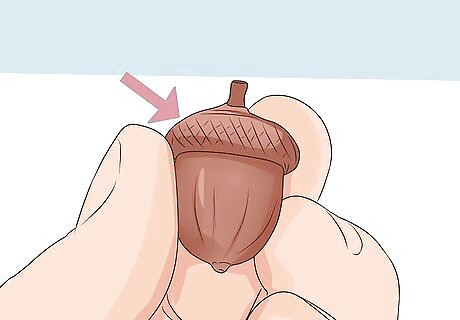
Examine the acorn cup scales. The nut of the acorn grows from a woody cup, which may remind you of a hat. The small scales that make up the cup may be thin and flat, or thick and forming wart-like growths (tubercles). This variation is a great start for narrowing down the possible species. All oaks native to North America and Europe have a spiral of overlapping scales on the cup. Some (but not all) East Asian oaks have scales that form concentric rings instead. These are called ring-cupped oaks, and belong to the Cyclobalanopsis subgenus.
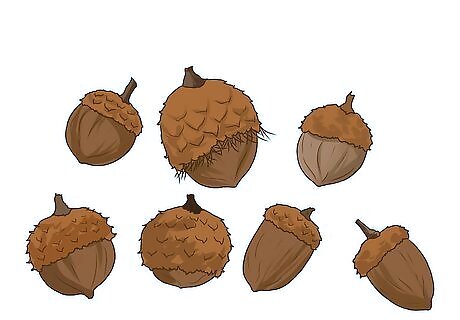
Look at the shape of the acorn. Acorns come in many shapes, but you can divide them into two rough groups. Some are round ("globose"), or nearly round with a blunt tip. Others are elongated ("ovoid" or "oblong") and usually taper to a point ("fusiform"). The acorns of some species have parallel ridges (striations) running between the two points. This can vary within one species, so a smooth acorn isn't always diagnostic.
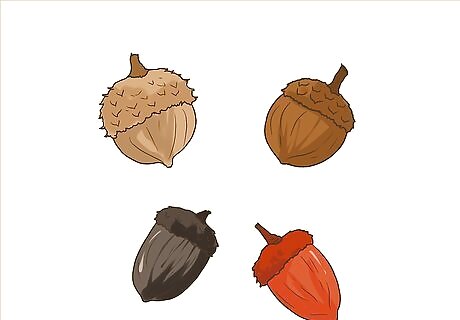
Check the color. Mature acorns can be light brown, dark brown, black, or chestnut red. If the acorn is still green or greenish-grey, it probably fell off the tree early.
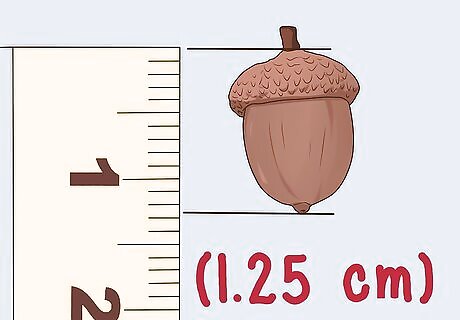
Measure the nut. Acorns range in size from nubs less than ½ inch (1.25 cm) long, to behemoths the size of your palm. Most acorns within a single species and region are similar in length within about ½ inch (1.25 cm). One important exception is the cork oak of the Mediterranean, which drops large acorns in autumn and a smaller batch in winter. The size and shape of the cup is also useful, and you can easily eyeball it by comparing it to the nut. For example, the Northern red oak has a cup that sits flat at the top of the nut, while the overcup oak and bur oak wrap almost the entire nut in a cup. The length of the stalk the acorn grows on can also help identification.

Look for hairs. The cup of some acorns have hairs on the inner and/or outer surface. You can also look for hairs on the inner surface of the shell, after cracking it open. Botanists describe this hairy material with these terms: Woolly: long, matted hairs. Some species only have hair near the tip of the acorn, so check there. Pubescent: short, fine hairs. Glabrous: smooth.

Look for germinating acorns. If an acorn on the ground is sprouting through its shell, it must belong to a species that germinates at this time of year. In North America, oaks are divided into white oaks, which sprout in fall right after the acorns drop, and red oaks, whose acorns spend the winter dormant and sprout in spring. Here, we're talking about the white and red oak categories. These include the specific species "white oak" and "red oak," but there are many more possibilities. Most acorns lose their cup before sprouting. The Asian ring-cupped species are the main exceptions.
Identifying Common USA Oak Species
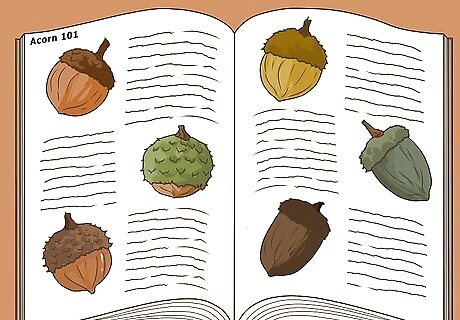
Find a local field guide if possible. There are about 400 species of oak worldwide, and over 200 in North America. This guide only covers a few of the most common species in the United States. A tree identification guide for your region or state will help for the species that are less common or limited to smaller areas.

Choose your region. This guide is divided by the region where the oaks grow. Note that many species only grow in a smaller area within this region. Central and Eastern United States: East of Minnesota in the north and Texas in the South. Florida is included, but many species do not grow there. Western United States: This covers the entire Midwest and Pacific coast.
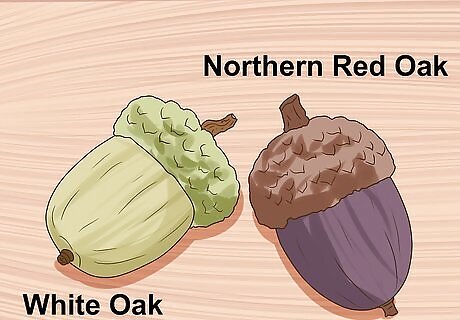
Narrow down brown, oblong acorns. These acorns have the classic oblong or ovoid acorn shape. Their nuts are light brown or dark brown in color, with few to no red tones. Here are the most common species that fit this description in this region, and their identifying characteristics: White oak (Quercus alba): short, light grey cup with warty scales; cup covers about ¼ of nut Chinkapin oak (Quercus muehlenbergii): thin cup with fine grey hairs and moderately warty scales; cup covers ¼ to ½ of nut Scarlet oak (Quercus coccinea): glossy, dark reddish-brown cup; nut has a blunt tip Willow oak (Quercus phellos): shallow, flattened cup with hairs inside and out; nut is less than ½" (13 mm) long Northern red oak (Quercus rubra): cup scales are reddish-brown, hairy, often with dark margins; inside of cup is smooth or has ring of hair around the scar; nut may have grey stripes Shumard oak (Quercus shumardii): Similar to Northern red oak, but scales often have pale margins; some have a deeper, bowl-shaped cup, but not all

Identify other acorns of the region. These species produce acorns that are round or have a distinct color or shape: Bur oak (Quercus macrocarpa): The largest acorns on the continent, about 1.5 inches (4 cm) long with a very deep cupule that covers at least half of the nut Water oak (Quercus nigra): shallow cup with fine hairs; round, blackish nut Southern red oak (Quercus falcata): thin, reddish-brown cup with fine hairs; nut sometimes have lines and hairs near tip. Pin oak (Quercus palustris): thin, smooth, reddish-brown cup; light brown nut is often striped, and can be either round or ovoid Post oak (Quercus stellata): thin cup with grey, hairy scales; light brown nut ¾" (19 mm) long or less, sometimes with faint dark brown stripes; nut can be round or ovoid Black oak (Quercus velutina): reddish-brown, hairy cup with a knob on top and a fringed edge; hair inside cup as well; light reddish-brown, ovoid nut with faint stripes
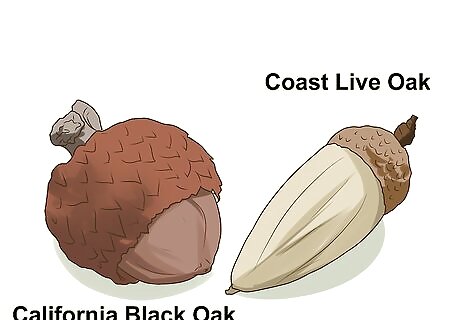
Learn about California oaks. California is dominated by oaks of many species, and naturally occurring hybrids. Here are some of the most common in various parts of California: California black oak (Quercus kelloggii): found throughout the state. Nut usually at least 1 inch (2.5 cm) long, cup varies but scales at margin are usually loose and may be warty Coast live oak (Quercus agrifolia): found along the coast. Variation makes identification by acorn tough, but cup scales have loose tips and are never warty. Blue oak (Quercus douglasii): found mostly in north and central California. Cup is extremely shallow with thin scales. Engelmann oak (Quercus engelmannii): found in the extreme south. Light brown, oblong nut. Cup has grey hairy scales, warty at the fringe
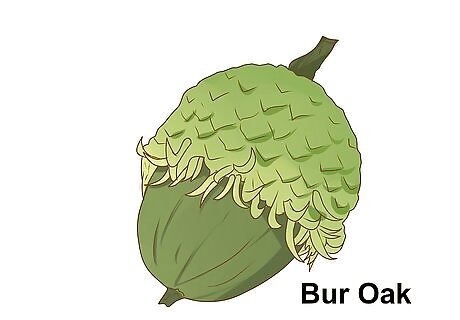
Know the oaks of the Great Plains. Scattered oaks are found throughout this region, but of course they are only plentiful in forested sub-regions: Bur oak (Quercus macrocarpa): Found in the northeast Great Plains. 1.5 inch (4 cm) acorns with a cup that covers more than half the acorn. Post oak (Quercus stellata): Found in the Cross Timbers region. No more than ¾" (19 mm) long, light brown; grey, thin, hairy cup Blackjack oak (Quercus marilandica): Also in the Cross Timbers. Narrow nuts about ½" (13 mm) wide, half covered by the cup.
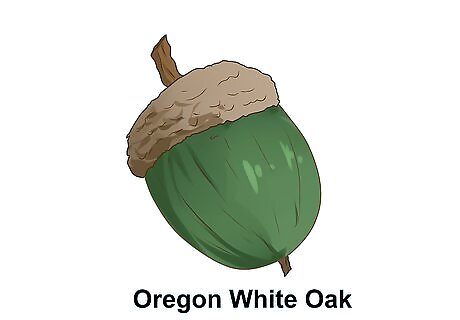
Identify oaks in the Pacific Northwest. Much of the oak habitat in this region has disappeared. These three are the remaining species: Oregon white oak / Garry oak (Quercus garryana): The only oak in Washington state, and the most common one in Oregon. Nut is large (1 inch / 2.5cm+) and cup is shallow with yellowish or reddish brown scales. California black oak (Quercus kelloggii): found in southern Oregon. See California oaks above. Canyon live oak (Quercus chrysolepis): found in southern Oregon. Its acorns are extremely variable, so treat it as a "catch all" for this region. (Also present in CA and NM, where it is easily confused with the numerous other species.)

















Comments
0 comment